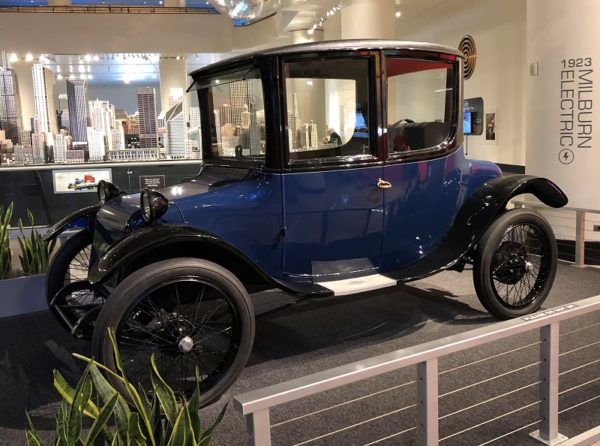
The talk these days is of electric cars – but they are by no means new. The Museum of Science and Industry has two examples: the first Tesla sports car, built in 2008 and based on a Lotus Elise; and this charming Milburn.
By World War I the car powered by internal combustion had soundly beaten its steam and electric competitors. Yet the electric car remained a practical machine for city travel – and this machine was touring the streets of Chicago from 1923 to 1933.
George Milburn (1820-1883) was born in Alston, England. He emigrated to Canada and then to Indiana, married and took up farming. There was a direct connection to motoring, however: his daughter Ann later became the wife of Clement Studebaker. The family finally settled in Mishawaka, Indiana – and it was here that in 1848 Milburn started the George Milburn Co., owning a prosperous general store. He invested in a range of enterprises from an axle company to a hotel, and in 1869 founded the Milburn Wagon Company. This moved to Toledo, Ohio in 1875 and became the largest manufacturer of farm wagons in the world.
Even before 1910 Milburn was producing bodies for the Ohio Electric car company and for companies making gasoline-engined cars. A plan to merge Milburn and Ohio to make electric cars fell through, and Milburn decided to use his vast manufacturing facilities to make electric cars, convinced that he could make them lighter, lower and cheaper. The first Milburn Light Electric was made in September 1914. It was based on a design by Karl Probst, who later designed the Bantam Jeep. 4,000 cars were made between 1914 and 1923.
The Milburn plant was destroyed by fire in 1919, but by January 1920 production had restarted and returned to the employment of 800 men, 200 on cars and 600 building automobile bodies, largely for Oldsmobile. In February 1923, General Motors purchased the Milburn Body Plant. But Milburn retained the right to make electric vehicles under their name and continued to make a few vehicles, in particular their Model 27L, at a smaller factory. Sadly, it appears that this was the last year of electric car production.
The Milburn Electrics were among the most popular and elegant cars of the time and were used by President Woodrow Wilson’s secret service men. President Wilson himself owned a 1918 Milburn Electric, which he drove around the White House grounds.
The Milburn 27L in our Snapshot is one of very few to survive (we mentioned one in our Hershey report in 2018) – and perhaps for a very good reason. University of Chicago football coach Amos Alonzo Stagg bought the car to overcome his impaired mobility on the field during practices and games. He kept the car until 1933, when he donated it to the museum where it resides in splendour to this day – and forms an historical marker for the present revival in electric transportation.







Leave a Comment